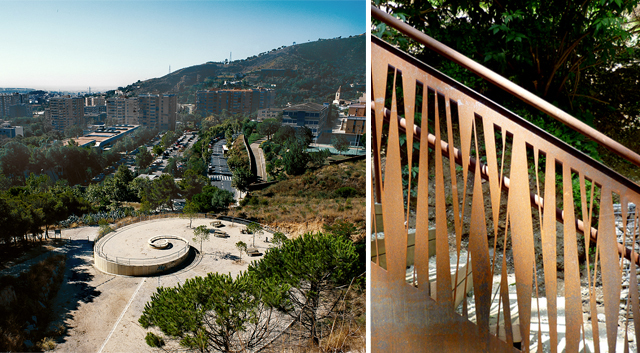Minutes away from the bustling center of Barcelona lies the word’s biggest metropolitan park. Covering a large part of the Collserola mountain range, the Natural Park of the same name is a balanced mix of natural and man-made spaces. BiniChic recently sat down with Josep Mascaró, the landscape architect in charge of the architectural and restoration interventions that make the Collserola Park a beautifully integrated area.

Josep Mascaró studied architecture in Barcelona, starting his career designing houses in Spain and Venezuela before becoming a landscape architect. Mr. Mascaró’s work reflects the belief that nature is the best designer. His designs are often inspired by natural forms — letting his interventions be as minimal and as integrated with their surroundings as possible.

BiniChic: You studied architecture, what made you become a landscape architect?
J. Mascaró: Several things, one of which was coincidence. I moved to Venezuela to work as an architect, and started collaborating with a landscaper who I found very interesting.
But actually, I really liked the idea that instead of constructing one could deconstruct and take away the things that were unnecessary. In the 70s and 80s, my design partner and I made a lot of houses in Menorca. I remember thinking when a project was completed that there there was now less natural space on the island — something I eventually felt like changing.

BiniChic: What differences do you see between the way landscaping is approached in Barcelona as opposed to other parts of the world?
J.Mascaró: Barcelona was one of the first places in the world to start doing a more urbanized landscaping, with less natural components than you might find in other cities. For better or for worse, we were pioneers in this approach, and that allowed for a lot of experimentation and innovative designs. A good example would be Albert Viaplana’s Plaça dels Països Catalans, which is a completely urbanized square lacking any greenery. Even Antoni Gaudí’s squares in the Güell Park were very innovative for their time. He projected completely artificial, elevated spaces that didn’t incorporate a lot — if any — natural elements, but instead interpreted nature’s shapes into a man-made structure.

BiniChic: What role does Collserola play in Barcelona — and what is your own role in the Collserola park?
J. Mascaró: Collserola became a Natural Park in 2001, but it’s also a very large metropolitan park. It structures an area of practically 4 million inhabitants and has 9 municipalities bordering it. The park gives what could be a very dense metropolitan area some breathing space — it’s the Central Park of the Barcelona area.
For the past twenty years, I have been working in the department in charge of conservating and making Collserola user-friendly. We are in charge of designing paths, itineraries, viewpoints, leisure areas, cleaning the forest and restoring buildings and elements that already existed before becoming a natural park.
It’s a very natural landscaping type of work but with architectural elements, which I thoroughly enjoy.

BiniChic: How would you describe your creative process? Who or what inspires you?
J. Mascaró: Foremost in my creative process is the fact that my landscaping is on a natural space, as opposed to a city. Unlike a landscaper who must create a natural space within a city — like Olmsted did in New York City — I must work with the very potent natural spaces before me. The more you design the architectural elements in function of their surroundings, the better they will integrate — otherwise they will clash and nature will most likely win.
I’m very inspired by painters. Classics such as Turner and DaVinci fascinate me — they both tackled difficult themes such as representing water and clouds. I also like looking at the work of biologists, geographers, naturalists and botanists. Actually, the ones by whom I’m least inspired are generally architects.

BiniChic: What would you like to do in Collserola — or Barcelona — so it continues to be a city with large green areas?
J. Mascaró: Basically, I would like to see the park conserved as is — with its protected flora and fauna — and continue to improve it to create a completely integrated natural space. I would like for the people of Barcelona to consider the Collserola Park as their own garden and leisure area.
I feel very lucky to have helped create such a large metropolitan park — I hope that it serves as a reference for metropolitan landscapers around the world. Appreciated for its natural systems, as well as for the architectural actions done in order to protect and habilitate it for human use.

All photos and projects in this post are by Josep Mascaró for the Collserola Park of Barcelona.




Wow, wonderful post! Impressed that you were able to speak to the architect, too!
Pingback: Form Follows Function | BiniChic